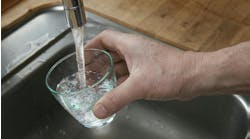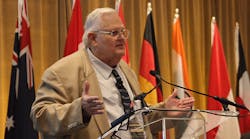CRYSTAL CITY, VA. — There have been a lot of steps taken to conserve water, such as low-consumption water closets and low flow fittings, but there are plenty of steps that can still be taken that rely on existing technology and aren’t particularly difficult. Nationally known engineer Bill Hoffman covered some of them in his presentation, “Three Emerging Technologies that Save Water and Energy,” at the International Emerging Technology Symposium here in late April.
At the International Emerging Technology Symposium, speakers from across the spectrum of the plumbing and mechanical industry discussed the latest products, technology, trends and best practices in the field. The International Emerging Technology Symposium was co-convened by American Society of Plumbing Engineers, the Canadian Institute of Plumbing & Heating, the International Association of Plumbing & Mechanical Officials, the Mechanical Contractors Association of America, Plumbing-Heating-Cooling Contractors – National Association, Plumbing Manufacturers International, the United Association, and the World Plumbing Council.
Bill Hoffman is a principal with H.W. Hoffman and Associates LLC, a water resource planning and conservation services firm located in Austin, Texas, and advisor and engineer for Water Management Inc. A fifth generation Texan and die-hard University of Texas Longhorn, Hoffman is the former Program Coordinator for Industrial, Commercial and Institutional Water Conservation Programs for the City of Austin. He’s been on a dizzying number national, state and local industry committees, including IAPMO’S Green Technical Committee.
Hoffman’s three ideas include using onsite sources of water, slashing water use in cooling towers, and killing dipper wells.
We are not running out of water, Hoffman began; we just have too many people.
The first idea is to use onsite rainwater and graywater recovery and reuse for both the water and its embedded energy. Graywater comes predominantly from heated sources such as showers and laundry and it can be run through a heat exchanger to preheat incoming water.
Hoffman’s beloved University of Texas captures water from every source possible, including air conditioning condensate. The new Bank of America Tower in New York City captures rainwater, graywater, foundation drain water and air conditioning condensate. Most of downtown San Francisco’s buildings use alternative water sources, Hoffman reported, because its water infrastructure was designed to supply drinking water to low-rise buildings and not the skyscrapers that make up its skyline now. Sixty percent of the non-potable water used in downtown Tokyo comes from onsite recovery and reuse.
Hoffman also is a believer in “sewer mining,” i.e., using onsite, decentralized water treatment to purify water for non-potable uses and to extract any heat in the effluent.
Cut cooling tower water
Cooling towers get rid of “unwanted energy” in the form of heat by evaporating much-wanted water. In Texas, 60% of the water used in commercial buildings is used either for cooling towers or for boiler makeup. There are other ways to cool condensers that don’t involve sacrificing drinking water. Nationally, he said, half of the water used in commercial buildings is used in cooling towers.
Switzerland, as an example, uses heat exchangers in the sewers to exchange heat for the condensers.
Hoffman advocates geothermal, citing the example of the Frisco (Texas) Independent School District.
FISD, which is near Dallas, began using geothermal heat pump systems to provide HVAC to schools in 2002. As the fastest growing district in the state for several years, the Frisco school district has opened multiple schools and facilities each year since 1999. The district is able to compare vast amounts of data between the high school, middle schools and elementary schools constructed prior to use of geothermal heat pumps and the schools constructed with the heat pumps, according to Director of Construction Services Cecil Cypert.
Cypert says 17 of FISD’s 28 currently operating elementary schools when compared to the older schools with traditional HVAC systems provide the district energy savings of 34%. The five middle schools have offered a savings of 51% compared to their older counterparts. The districts two older high schools (though both relatively new construction) Frisco High School and Centennial High School, have traditional HVAC. The four newer high schools including Lone Star have geothermal. The savings between the high schools are estimated at 59%.
None of this, Hoffman would point out, involves spraying water through a cooling tower.
Another tactic would be to use the heat coming from a combined heat and power system to dry out a desiccant wheel to remove humidity from makeup air. You can use this in any region, especially east of the Mississippi, that has a substantial latent load. Using desiccants to remove humidity takes a lot of the load off a greatly downsized cooling tower.
Dump the dipper well
Finally, Hoffman wants to eliminate dipper wells. It’s not that he has anything against ice cream or ice cream parlors, but many dipper wells run water through them all day long. Starbucks, for example, had 6 million gallons per day running through dipper wells company-wide. Starbucks has since gone to rinsing ice cream scoops in sinks but its baristas too often put the scoop in the sink and let the water run. That is, however, a training problem not a system problem. The University of Nevada Las Vegas performed a study that found that 300,000-GPD was running through the desert town’s dipper wells.
There are better ways to remove ice cream from scoops. One product from a firm named ConserveWell heats standing water to a sanitizing 140°F and the water is dumped only on an as-needed basis. Finally, Hoffman noted that a German product dubbed Rinsewell sprays water at a dirty dipper from four directions for 10 seconds and uses 0.226-gal. per 10-second cycle.


